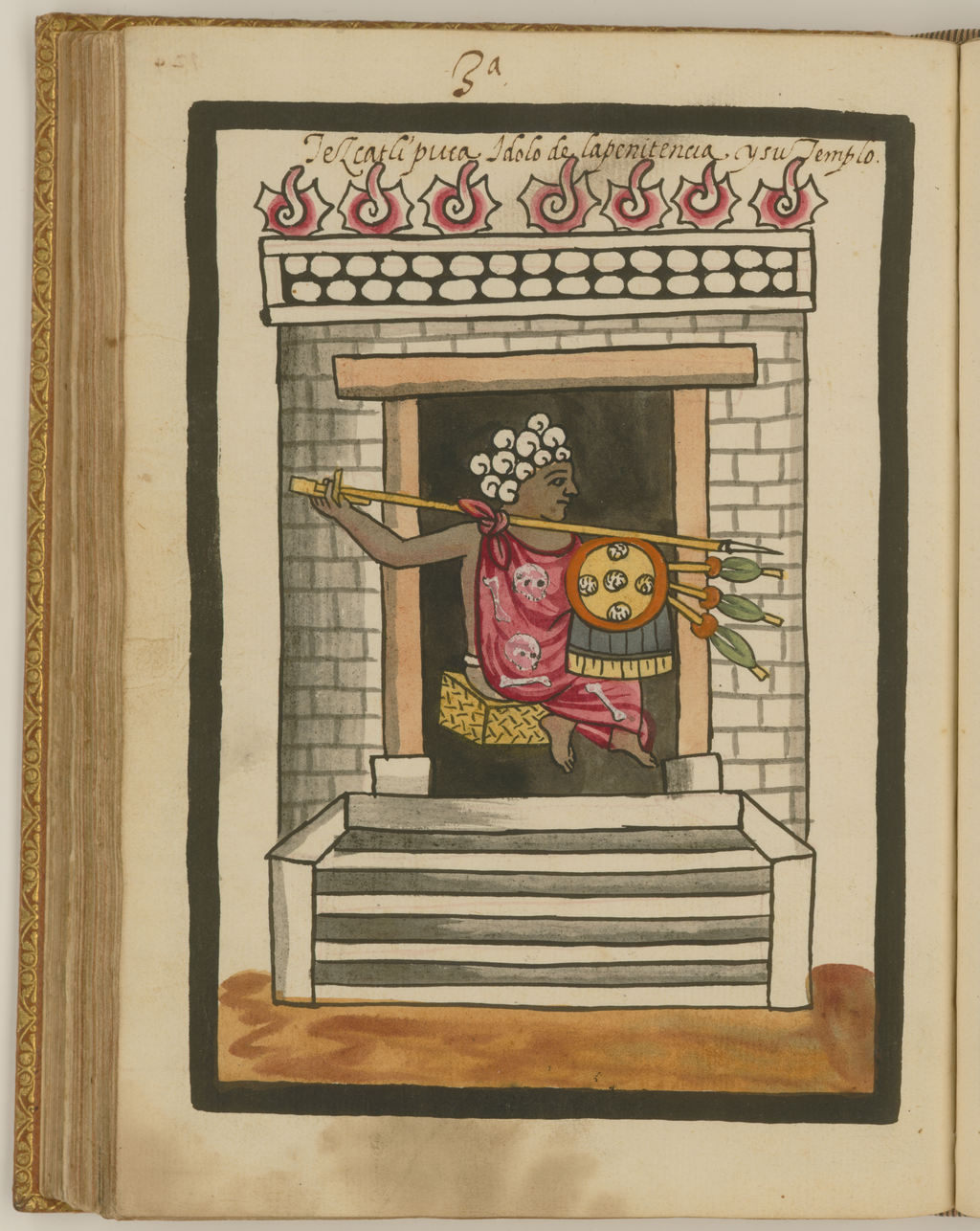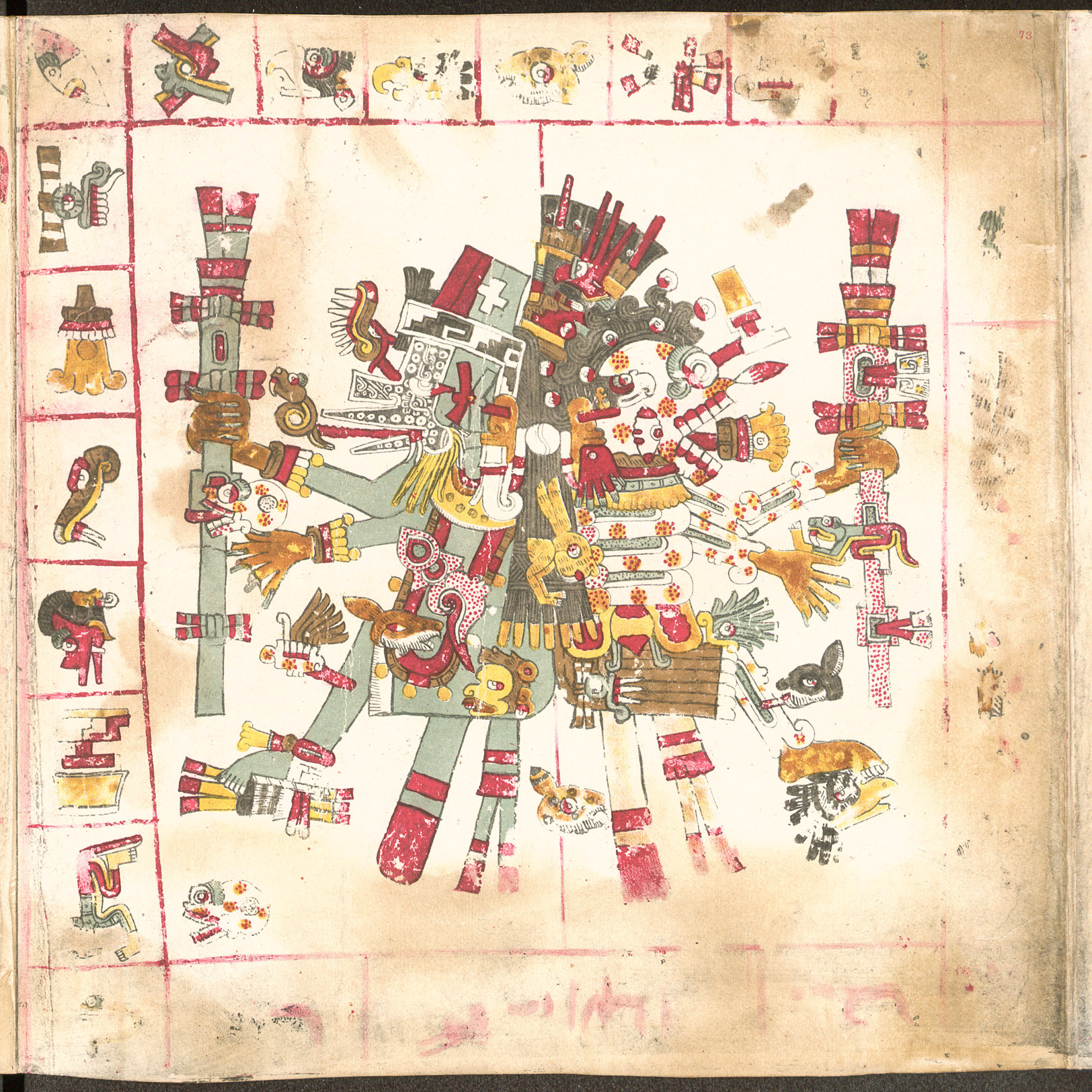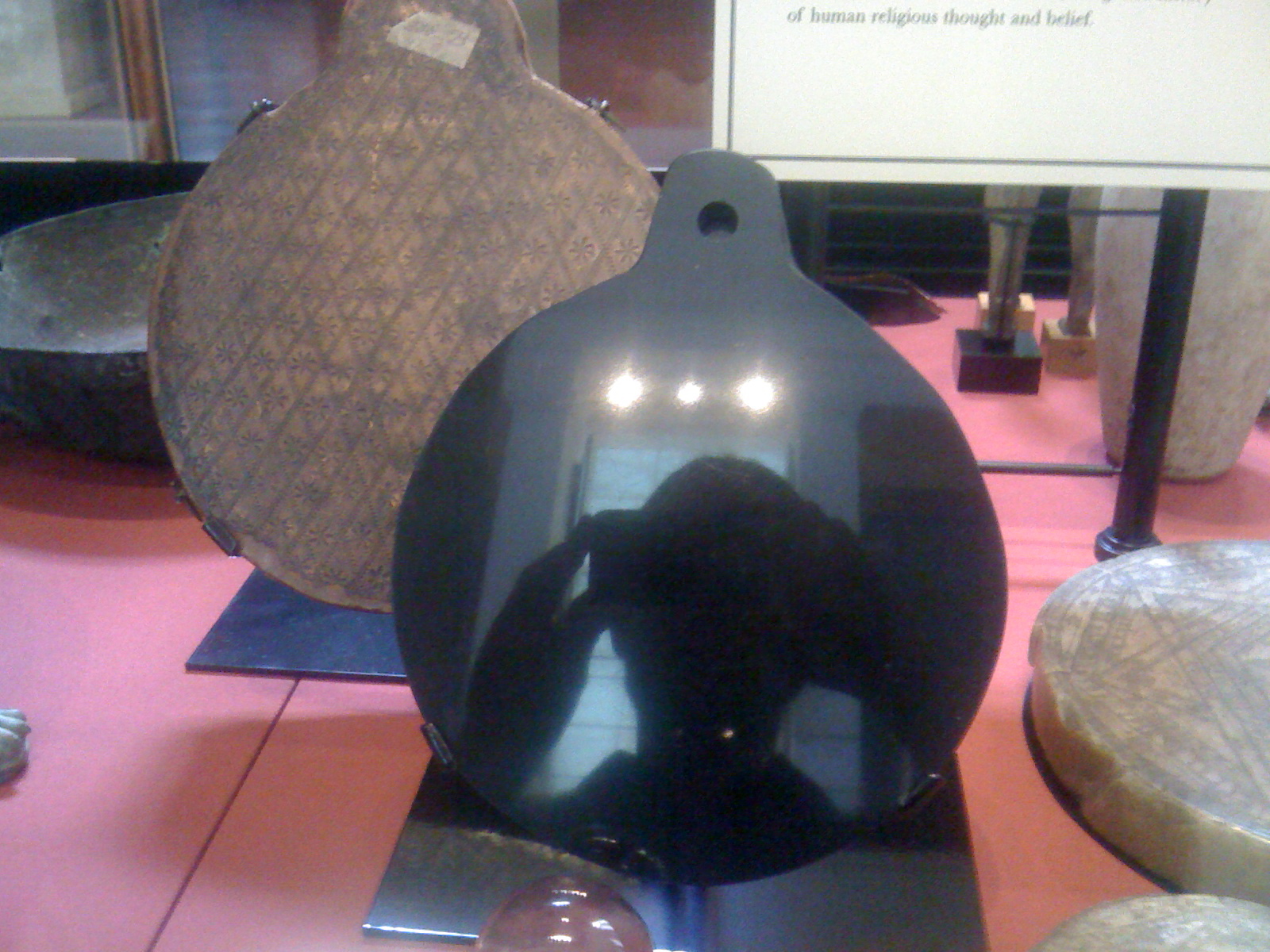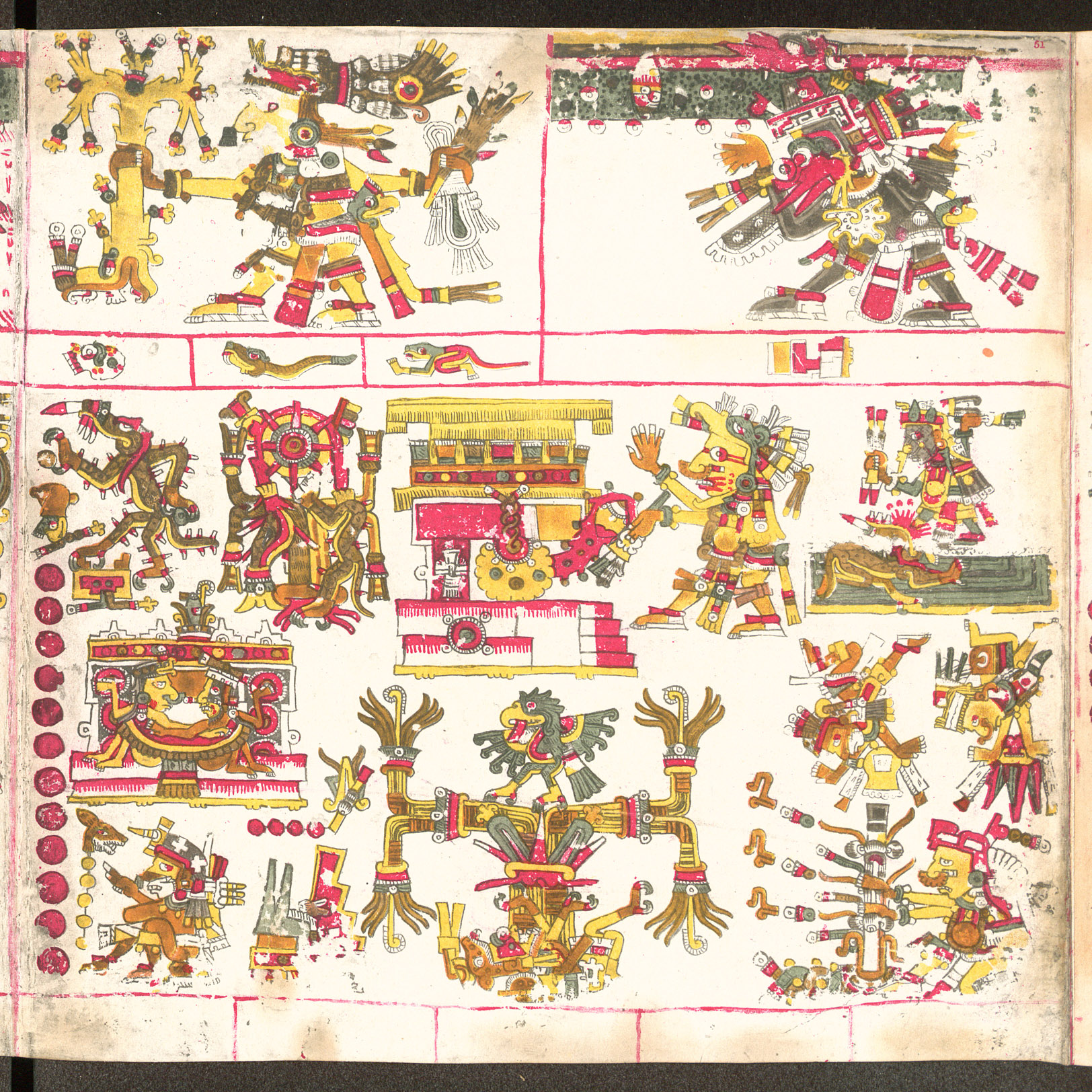|
Tezcatlipoca
Tezcatlipoca (; nci, Tēzcatl ihpōca ) was a central deity in Aztec religion, and his main festival was the Toxcatl ceremony celebrated in the month of May. One of the four sons of Ōmeteōtl, Ometecuhtli and Omecihuatl, the God of providence, he is associated with a wide range of concepts, including the night sky, the night winds, hurricanes, the north, the earth, obsidian, hostility, discord, rulership, divination, temptation, Jaguars in Mesoamerican cultures, jaguars, sorcery, beauty, war, and conflict. His name in the Nahuatl language is often translated as "Smoking Mirror" and alludes to his connection to Obsidian use in Mesoamerica, obsidian, the material from which Mirrors in Mesoamerican culture, mirrors were made in Mesoamerica and which were used for shamanism, shamanic rituals and prophecy. Another talisman related to Tezcatlipoca was a disc worn as a chest pectoral. This talisman was carved out of abalone shell and depicted on the chest of both Huitzilopochtli and ... [...More Info...] [...Related Items...] OR: [Wikipedia] [Google] [Baidu] |
Tezcatlipocas
In Aztec mythology, Creator-gods are the only four Tezcatlipocas, the children of the creator couple Ometecuhtli and Omecihuatl "Lord and Lady of Duality", "Lord and Lady of the Near and the Close", "Father and Mother of the Gods", "Father and Mother of us all", who received the gift of the ability to create other living beings without childbearing. They reside atop a mythical thirteenth heaven Ilhuicatl-Omeyocan "the place of duality". Each of the four sons takes a turn as Sun, these suns are the Five Suns, sun of earth, the Five Suns, sun of air, the Five Suns, sun of fire, the Five Suns, sun of water (Tlaloc, rain god replaces Xipe-Totec). Each world is destroyed. The present era, Five Suns, the Fifth Sun is ushered in when a lowly god, Nanahuatzin sacrifices himself in fire and becomes Tonatiuh, the Fifth Sun. In his new position of power he refuses to go into motion until the gods make sacrifice to him. In an elaborate ceremony, Quetzalcoatl cuts the hearts out of each of the ... [...More Info...] [...Related Items...] OR: [Wikipedia] [Google] [Baidu] |
Xipe-Totec
In Aztec mythology and religion, Xipe Totec (; nci-IPA, Xīpe Totēc, ˈʃiːpe ˈtoteːk(ʷ)) or Xipetotec ("Our Lord the Flayed One") was a life-death-rebirth deity, god of agriculture, vegetation, the east, spring, goldsmiths, silversmiths, liberation, and the seasons. Xipe Totec was also known by various other names, including Tlatlauhca (), Tlatlauhqui Tezcatlipoca () ("Red Smoking Mirror") and Yohuallahuan () ("the Night Drinker"), and Yaotzin ("revered enemy"). The Tlaxcaltecs and the Huexotzincas worshipped a version of the deity under the name of Camaxtli, and the god has been identified with Yopi, a Zapotec god represented on Classic Period urns.Miller & Taube 1993, 2003, p.188. The female equivalent of Xipe Totec was the goddess Xilonen- Chicomecoatl. Xipe Totec connected agricultural renewal with warfare. He flayed himself to give food to humanity, symbolic of the way maize seeds lose their outer layer before germination and of snakes shedding their skin. He i ... [...More Info...] [...Related Items...] OR: [Wikipedia] [Google] [Baidu] |
Quetzalcoatl
Quetzalcoatl (, ; Spanish: ''Quetzalcóatl'' ; nci-IPA, Quetzalcōātl, ket͡saɬˈkoːaːt͡ɬ (Modern Nahuatl pronunciation), in honorific form: ''Quetzalcōātzin'') is a deity in Aztec culture and literature whose name comes from the Nahuatl language and means "Precious serpent" or " Quetzal-feathered Serpent". In the 17th century, Ixtlilxóchitl, a descendant of Aztec royalty and historian of the Nahua people, wrote, "Quetzalcoatl, in its literal sense, means 'serpent of precious feathers', but in the allegorical sense, 'wisest of men'." Among the Aztecs, whose beliefs are the best-documented in the historical sources, Quetzalcoatl was related to gods of the wind, of the planet Venus, of the dawn, of merchants and of arts, crafts and knowledge. He was also the patron god of the Aztec priesthood, of learning and knowledge. Quetzalcoatl was one of several important gods in the Aztec pantheon, along with the gods Tlaloc, Tezcatlipoca and Huitzilopochtli. Two other gods re ... [...More Info...] [...Related Items...] OR: [Wikipedia] [Google] [Baidu] |
Aztec Religion
The Aztec religion is a monistic pantheism in which the Nahua concept of was construed as the supreme god , as well as a diverse pantheon of lesser gods and manifestations of nature. The popular religion tended to embrace the mythological and polytheistic aspects, and the Aztec Empire's state religion sponsored both the monism of the upper classes and the popular heterodoxies. The Aztec Empire officially recognized the most popular cults such that the deity was represented in the central temple precinct of the capital . The imperial cult was specifically that of the distinctive warlike patron god of the Mexica . Subjugated peoples were allowed to retain their own religious traditions in conquered provinces so long as they added the imperial god to their local pantheons, while the Empire would often incorporate practices from its new territories into the mainstream religion. In common with many other indigenous Mesoamerican civilizations, the Aztecs put great ritual emphasis ... [...More Info...] [...Related Items...] OR: [Wikipedia] [Google] [Baidu] |
Aztec
The Aztecs () were a Mesoamerican culture that flourished in central Mexico in the post-classic period from 1300 to 1521. The Aztec people included different Indigenous peoples of Mexico, ethnic groups of central Mexico, particularly those groups who spoke the Nahuatl, Nahuatl language and who dominated large parts of Mesoamerica from the 14th to the 16th centuries. Aztec culture was organized into city-states (''altepetl''), some of which joined to form alliances, political confederations, or empires. The Aztec Empire was a confederation of three city-states established in 1427: Tenochtitlan, city-state of the Mexica or Tenochca; Texcoco (altepetl), Texcoco; and Tlacopan, previously part of the Tepanec empire, whose dominant power was Azcapotzalco (altepetl), Azcapotzalco. Although the term Aztecs is often narrowly restricted to the Mexica of Tenochtitlan, it is also broadly used to refer to Nahuas, Nahua polities or peoples of central Pre-Columbian Mexico, Mexico in the preh ... [...More Info...] [...Related Items...] OR: [Wikipedia] [Google] [Baidu] |
Mirrors In Mesoamerican Culture
The use of mirrors in Mesoamerican culture was associated with the idea that they served as portals to a realm that could be seen but not interacted with.Fitzsimmons 2009, pp.96–97. Mirrors in pre-Columbian Mesoamerica were fashioned from stone and served a number of uses, from the decorative to the divinatory.Miller and Taube 1993, 2003, p.114. An ancient tradition among many Mesoamerican cultures was the practice of divination using the surface of a bowl of water as a mirror. At the time of the Spanish conquest this form of divination was still practiced among the Maya, Aztecs and Purépecha. In Mesoamerican art, mirrors are frequently associated with pools of liquid; this liquid was likely to have been water.Healy and Blainey 2011, p.241.Healy and Blainey speculate that this liquid may have been mercury. Quantities of liquid mercury ranging from have been recovered from elite tombs or ritual caches at six Maya sites. Healy and Blainey 2011, p.241. Early mirrors were fashioned ... [...More Info...] [...Related Items...] OR: [Wikipedia] [Google] [Baidu] |
Codex Borgia
The Codex Borgia ( The Vatican, Bibl. Vat., Borg.mess.1), also known as ''Codex Borgianus'', ''Manuscrit de Veletri'' and ''Codex Yohualli Ehecatl'', is a pre-Columbian Middle American pictorial manuscript from Central Mexico featuring calendrical and ritual content, dating from the 16th century. It is named after the 18th century Italian Cardinal, Stefano Borgia, who owned it before it was acquired by the Vatican Library after the Cardinal's death in 1804. The Codex Borgia is a member of, and gives its name to, the Borgia Group of manuscripts. It is considered to be among the most important sources for the study of Central Mexican gods, ritual, divination, calendar, religion and iconography. It is one of only a handful of pre-Columbian Mexican codices that were not destroyed during the conquest in the 16th century; it was perhaps written near Cholula, Tlaxcala, Huejotzingo or the Mixtec region of Puebla. Its ethnic affiliation is unclear, and could either have been produced by ... [...More Info...] [...Related Items...] OR: [Wikipedia] [Google] [Baidu] |
Thirteen Heavens
The Nahua people such as the Aztecs, Chichimecs and the Toltecs believed that the heavens were constructed and separated into 13 levels, usually called Topan or simply each one Ilhuicatl iohhui, Ilhuicatl iohtlatoquiliz. Each level had from one to many Lords (gods) living in and ruling them. Aztec mythology In Aztec mythology, the Thirteen Heavens were formed out of Cipactli's head when the gods made creation out of its body, whereas Tlaltícpac, the earth, was made from its center and the nine levels of the underworld ( Mictlan) from its tail. The most important of these heavens was Omeyocan (Place of Two), where Ometeotl - the dual Lord/Lady, creator of the Dual-Genesis who, as male, takes the name Ometecuhtli (Two Lord), and as female is named Omecihuatl (Two Lady) - resided. References Bibliography See also * Aztec mythology * Aztec philosophy * List of Aztec gods and supernatural beings This is a list of gods and supernatural beings from the Aztec c ... [...More Info...] [...Related Items...] OR: [Wikipedia] [Google] [Baidu] |
Toltec
The Toltec culture () was a Pre-Columbian era, pre-Columbian Mesoamerican culture that ruled a state centered in Tula (Mesoamerican site), Tula, Hidalgo (state), Hidalgo, Mexico, during the Epiclassic and the early Post-Classic period of Mesoamerican chronology, reaching prominence from 950 to 1150 CE. The later Aztec culture saw the Toltecs as their intellectual and cultural predecessors and described Toltec culture emanating from Tollan, ''Tōllān'' (Nahuatl language, Nahuatl for Tula) as the epitome of civilization; in the Nahuatl language the word ''Tōltēkatl'' (singular) or ''Tōltēkah'' (plural) came to take on the meaning "artisan". The Aztec oral tradition, oral and pictographic tradition also described the history of a Toltec Empire, giving lists of rulers and their exploits. Modern scholars debate whether the Aztec narratives of Toltec history should be given credence as descriptions of actual historical events. While all scholars acknowledge that there is a lar ... [...More Info...] [...Related Items...] OR: [Wikipedia] [Google] [Baidu] |
Jaguar
The jaguar (''Panthera onca'') is a large cat species and the only living member of the genus '' Panthera'' native to the Americas. With a body length of up to and a weight of up to , it is the largest cat species in the Americas and the third largest in the world. Its distinctively marked coat features pale yellow to tan colored fur covered by spots that transition to rosettes on the sides, although a melanistic black coat appears in some individuals. The jaguar's powerful bite allows it to pierce the carapaces of turtles and tortoises, and to employ an unusual killing method: it bites directly through the skull of mammalian prey between the ears to deliver a fatal blow to the brain. The modern jaguar's ancestors probably entered the Americas from Eurasia during the Early Pleistocene via the land bridge that once spanned the Bering Strait. Today, the jaguar's range extends from core Southwestern United States across Mexico and much of Central America, the Amazon rainfo ... [...More Info...] [...Related Items...] OR: [Wikipedia] [Google] [Baidu] |
Ōmeteōtl
() ("Two gods") is a name used to refer to the pair of Aztec deities and , also known as and . translates as "two" or "dual" in Nahuatl and translates as "god". The existence of such a concept and its significance is a matter of dispute among scholars of Mesoamerican religion. Ometeotl was one as the first divinity, and Ometecuhtli and Omecihuatl when the being became two to be able to reproduce all creation Definition Multiple Nahuatl sources, notably the ''Florentine Codex'', name the highest level of heaven or "place of duality" ( specifically terms it "in in " or "the place of duality, above the nine-tiered heavens)." In the , Franciscan priest translated a Nahuatl source reporting that in this layer of heaven there existed "a god named , which means two-gods, and one of them was a goddess." The ''History of the Mexicans as Told by Their Paintings'' () names the inhabitants of the uppermost heaven and (Lord and Lady of Abundance). concurs that these are epith ... [...More Info...] [...Related Items...] OR: [Wikipedia] [Google] [Baidu] |
Obsidian
Obsidian () is a naturally occurring volcanic glass formed when lava extrusive rock, extruded from a volcano cools rapidly with minimal crystal growth. It is an igneous rock. Obsidian is produced from felsic lava, rich in the lighter elements such as silicon, oxygen, aluminium, sodium, and potassium. It is commonly found within the margins of rhyolite, rhyolitic lava flows known as obsidian flows. These flows have a high content of silicon dioxide, silica, granting them a high viscosity. The high viscosity inhibits atomic diffusion, diffusion of atoms through the lava, which inhibits the first step (nucleation) in the formation of mineral crystals. Together with rapid cooling, this results in a natural glass forming from the lava. Obsidian is hard, Brittleness, brittle, and amorphous; it therefore Fracture (mineralogy)#Conchoidal fracture, fractures with sharp edges. In the past, it was used to manufacture cutting and piercing tools, and it has been used experimentally as surgic ... [...More Info...] [...Related Items...] OR: [Wikipedia] [Google] [Baidu] |









